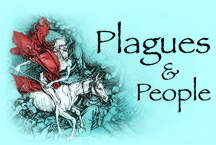
Infectious and Epidemic Disease in History
Department of History
University of California, Irvine
Instructor: Dr. Barbara J. Becker
Report on the Bilious Fever by the College of Physicians |

Department of History
University of California, Irvine
Instructor: Dr. Barbara J. Becker
Report on the Bilious Fever by the College of Physicians |
| Philadelphia, August 26th, 1793.
The college of physicians having taken into consideration the malignant and contagious fever that now prevails in this city, have agreed to recommend to their fellow citizens the following means of preventing its progress. 1st. That all unnecessary intercourse should be avoided with such persons as are infected by it.The college conceive fires to be very ineffectual, if not dangerous means of checking the progress of this fever. They have reason to place more dependence upon the burning of gunpowder. The benefits of vinegar and camphor are confined chiefly to infected rooms, and they cannot be used too frequently upon handkerchiefs, or in smelling-bottles, by persons whose duty calls to visit or attend the sick. Signed by order of the college, WILLIAM SHIPPEN, jun. Vice president. SAMUEL P. GRIFFITTS, Secretary. |
 |
| Go to: |
|
|